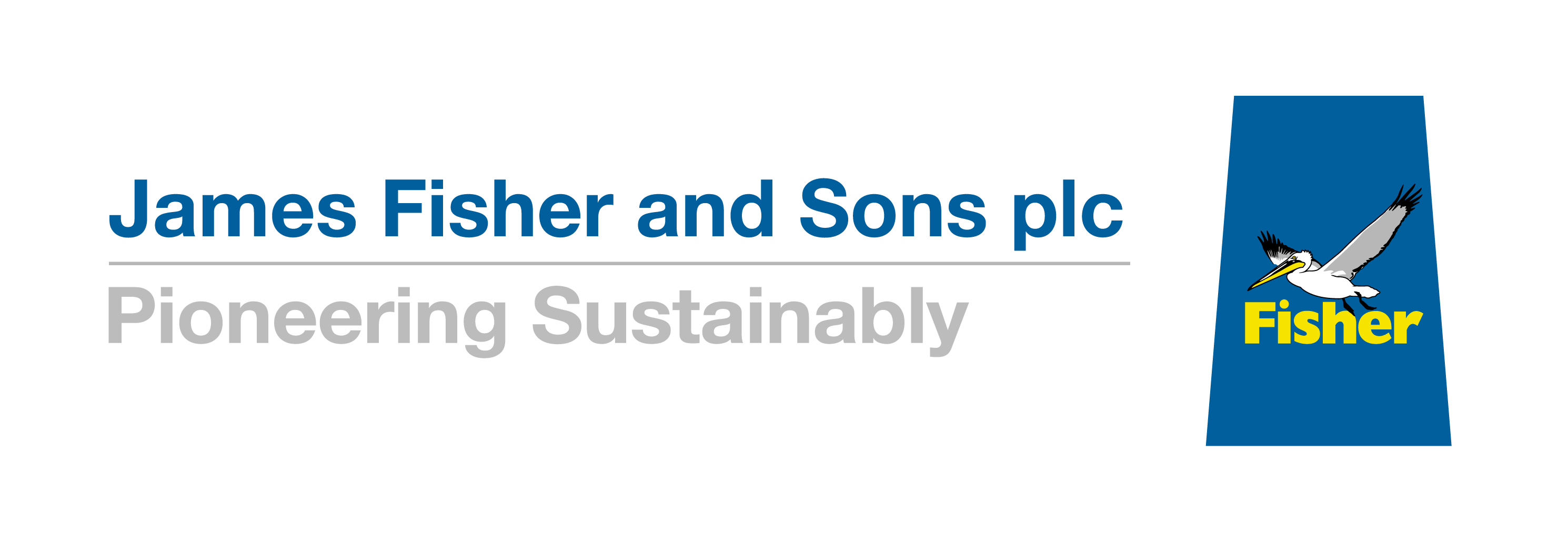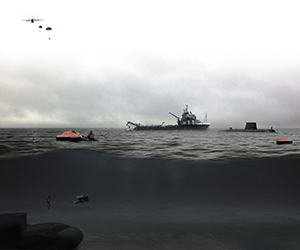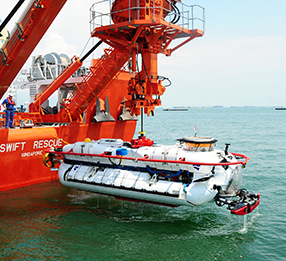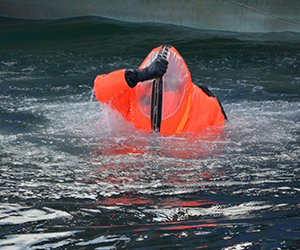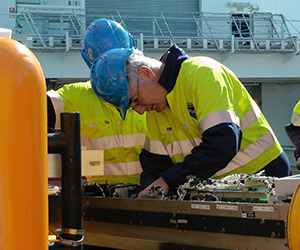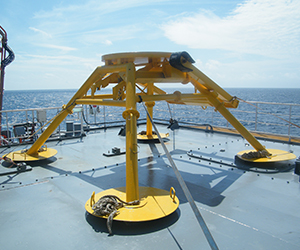
Submarine escape, rescue, abandonment and survival (SMERAS).
SMERAS is an internationally organised 'capability' which will involve almost any nation that can provide some assistance to the National Authority (NA) - the nation that owns the submarine.
This will include assets, people and support to the Submarine Search and Rescue Authority (SSRA) - the command and control organisation that will direct operations from naval headquarters, and the on scene commander (OSC) - the senior naval representative at sea. A DISSUB incident will require the assembly of a wide number of assets, people and organisations to undertake a successful recovery operation.
JFD is led by a highly capable, committed and experienced leadership team which truly understands the SMERAS requirement and naval service delivery. A rigorous set of management systems and processes and an unblemished safety record ensure that the company delivers high quality services around the clock around the world.
JFD can provide bespoke solutions for SMERAS equipment provision, training, operation, personnel resource and through-life support requirements. JFD can also undertake detailed policy or capability reviews and equipment and system inspections.
Capabilities
For both established and newly emerging submarine operating nations, JFD is able to advise on solutions across the entire SMERAS spectrum, ranging from low cost, intermediary solutions which fulfil the minimum requirements, through to highly integrated solutions encompassing all aspects of capability upgrade and training, with the aim being to maximise operational effectiveness. JFD is able to undertake or provide the following:
-
Studies. Reviewing current and desired capability requirements; undertaking a detailed Strategic Policy Review.
-
Designs. Developing solutions to meet customer-specific requirements.
-
Equipment. Supplying equipment to meet all training and operational needs.
-
Training. Providing a wide range of SMERAS-related training courses for new entry and experienced submariners, escape and rescue support personnel and those with overall command and control responsibilities for SUBSUNK.
-
Facilities. Design and delivery of shore-based SMERAS support and training facilities.
-
Personnel resource. Permanent contractor or surge team personnel for all aspects of maintenance, training and operation, including medical support.
-
Integrated Logistics Support. Offering cradle-to-grave through life support of equipment, systems and capability delivery.
-
CONOPS. Developing a clear illustration and definition of how the system will be delivered to meet the User requirements in terms of processes, procedures and operational deployment.
-
Contracting for Availability. Providing the equipment, training and through-life support for part or all of a particular SMERAS requirement, and working with the Customer to maximise cost-savings and delver maximum safety and reliability.
JFD’s capabilities are underpinned by over 30 years of providing submarine rescue operations and services to the Royal Navy, and more recently for the NATO Submarine Rescue System, jointly owned by France, Norway and the United Kingdom.
Similar agreements are in place with the Republic of Singapore Navy, and the Royal Australian Navy where JFD provide CO/CO (Contractor Owned/Contractor Operated) capability.
The company is constantly increasing global presence with established and emerging navies, as well as developing wider interests in subsea engineering design, manufacturing, commissioning, project management, training and emergency hyperbaric recovery responses for the offshore oil and gas sectors.
SMERAS is a complex subject and requires a wide-ranging portfolio of diverse functions and services to provide total capability. Accordingly, in addition to the full range of products and solutions outlined below, JFD is able to offer individual nations an initial assessment of their ability to respond in the event of a submarine accident. This can be undertaken by an Escape Inspection, primarily looking at the submarine and onboard systems, or with an Interim Capability Review which will cover the wider aspects of organisation and reactive response.
On completion, JFD can provide a full report with findings, recommendations, proposals and options for any necessary improvements.
Escape Inspections
Escape Inspections form an essential part in maintaining the ability of a submarine to conduct an escape, rescue or surface abandonment during an emergency. Conducted by JFD’s shorebased personnel with extensive submarine operating experience and specific additional qualifications in escape training, the Inspection is a fully-independent assessment of the escape compartments and escape towers including all fixed and consumable items; 1st and 2nd Reaction SUBSUNK Stores will also be inspected if held.
Functional testing of the submarine fitted Escape Tower breathing and/or Hood Inflation System will be conducted to confirm everything is in working order, critical safety defects will be identified and corrective actions recommended. Further advice will be provided on best practice to maintain, operate and document safety critical systems.
JFD staff have been directly responsible for conducting Escape Inspections during previous naval careers and a typical inspection will take approximately two days to complete, checking all necessary documents including breathing air certification documents, any lifting equipment and lifted items.
Interim Capability Review
Military capability is designed to meet national requirements after a thorough review of existing capability. The JFD Interim Capability Review will provide nations with an overview of their existing ability to respond to a submarine accident and interact with the well established international organisation and procedures.
SMERAS equipment encompasses on-board equipment within the platform itself, as well as equipment which remains shore-side and deployed at short notice in support of a DISSUB incident. JFD has considerable knowledge of the Naval Submarine Code and can offer design, manufacturing and support to meet all SMERAS requirements. Equipment can be adapted as necessary to integrate with existing on-board ship systems such as escape suits pressure regulating valves.
JFD can offer a cradle-to-grave approach in the design and supply of SMERAS related equipment and systems:
This capability can be applied to developing solutions across a wide range of equipment and systems including the following:
Escape Towers. The primary method of escape, these may also be combined with routine access on and off the submarine for special forces operations, and be surrounded by the rescue mating seat. Single-man and twin-man towers are in service with many navies. They are fitted with upper and lower hatches which form part of the submarine’s pressure-tight boundary. Each tower is outfitted with systems and fixtures to enable escape and re-supply of Emergency Life Support Stores (ELSS) by pod-posting to be safely conducted including all flood, drain and venting
- HP Air Systems. Escape from the Escape Towers using SESSPE is currently dependant on suitable HP Air supplies from the submarine. As a finite supply the use of HP Air has to be minimised as far as reasonably practicable during each escape cycle.
- Escape Stores. Stowed in dedicated lockers within the Escape Compartments and containing those items of equipment to initiate alertment, manage the Escape Compartment atmosphere, and provide adequate provisions to sustain the crew until either rescue arrives, or to prepare the crew to commence escape.
- Life Rafts for Abandonment. Stowed either within the submarine, or a suitable under-casing location, these multi-man life rafts provide additional safe refuge whilst awaiting surface rescue assets to arrive.
- Freeboard Extenders. Fitted within the cofferdam/hatch cavity recess and encompassing the upper parts of the escape tower, these are inflated during surface abandonment to reduce the risk of water ingress into the Escape Towers in rough weather or high angles of pitch and heel.
- Submarine Escape and Surface Survival Personnel Equipment (SESSPPE). Consisting of a suit with thermal base layers and a dedicated 1-man life raft and stowed within the Escape Compartments. Used for individual escape and subsequent sea survival. In some navies, the SESSPE is also used for surface abandonment.
- Intervention ROV (IROV). This provides the operator with a first on-scene capability to locate and survey the DISSUB, prepare for rescue and undertake ELSS pod-posting. The IROV is deployed with a dedicated underwater navigation, tracking and communications system which JFD is also able to supply, support and operate.
- 1st and 2nd Reaction Stores. Deployed on board the Escape Gear Ship and Rescue (or Intervention) MOSHIP respectively, these include escape support chambers and ELSS (e.g. for atmosphere control and medical care) to extend life before and during the rescue operation.
- Escape Support Chambers. Provide an on-scene capability for DISSUB escapers who reach the surface and require immediate hyperbaric assistance.
- Modular Option. As an innovative solution, JFD is designing a modular unit to be integrated with a submarine escape compartment to meet all onboard functional requirements. This will be based around a one or two-man escape tower and may include life raft, freeboard extenders and communications buoys. A unit will interface with existing electrical, air and water systems.
Equipment Supply
JFD offers a broad portfolio of bespoke and off-the-shelf products related to submarine escape, rescue, abandonment and survival.
-
DSAR Class Submarine Rescue Vehicle
-
ELSS Pods
-
Intervention ROVs
-
Equipment Upgrades
-
TUP Interface Equipment
-
Decompression Systems
-
Transfer Chambers
-
Training Targets
-
Launch & Recovery Systems
Facilities
Escape training represents one of the most challenging types of course offered by any military or civilian training establishment. Safety is of paramount importance and JFD is able to offer escape training which is directly drawn on the knowledge and experience developed from over 60 years of submarine escape training developed within the Royal Navy. The company is able to offer two types of escape training which both offer realistic experiential training whilst taking into account Customer needs and affordability.
Simulated Escape Tower
The Simulated Escape Tower is a portable low-cost method of providing realistic through-water escape training without subjecting the student to any pressurised ascent. The Simulated Escape Tower comprises of a lightweight cage containing two generic Escape Towers, within which the student can experience the effects of hood inflation, tower flooding, and buoyant ascent. The student is accompanied by a fully qualified diver throughout his time in the water and, most importantly, will be subjected to the absolute minimum increase in pressure.
This type of training is low risk and can be undertaken in any normal swimming pool with a depth of 4 metres and with suitable access for the cage hoisting equipment. The adjacent image illustrates a typical simulated escape tower system.
Pressurised Escape Training
Pressurised Escape Training is performed using a fully functioning escape tower designed to replicate as closely as possible the Escape Towers installed on the Customer’s platforms. The towers can be pressurised internally up to maximum of 3 Bar(G) and will be accessed from below via a representative Submarine Escape Compartment.
To achieve maximum experiential realism the tower will include:
-
Accurate dimensions and general appearance of the escape tower as fitted to the platform.
-
Lower and upper hatches with similar opening mechanisms, resistance to opening, closing, and mass.
-
Internal fixtures and fittings including ladders, Stole charging connections, guard rails, foot plates, flood valve, lighting, and ELSS Pod handling equipment.
-
External features including access ladders, flood, drain, and vent valves.
The training tower can be located within a representative Submarine Escape Compartment, similarly equipped with fixtures and fittings to replicate the Customer’s requirements.
JFD can also offer the design and build of a complete pressurised escape training facility based on those operated by leading navies. In this instance a pool of water (nominally 12m in diameter x 20m deep) is provided with an escape tower at the base of the structure, thereby allowing students to undertake a full pressurised ascent. Sea survival and surface abandonment skills can be taught at the surface.
Other features within the structure enable ascents from shallower depths. Such a facility readily lends itself to support the training needs of other military organisations (i.e. Special Forces) and other diving-related commercial interests.
Support Base
Nations may wish to consider a bespoke facility either within an existing naval or training base or in an appropriate forward operating location to support SMERAS. This would provide maintenance and storage for equipment, SUBSUNK Reaction Stores, intervention pod posting systems. JFD can advise as appropriate to provide a facility commensurate with a nation’s requirements.
SMERAS Training Centres
JFD is able to offer multi-functional facilities which encompass all elements of SMERAS training within the single facility. These provide high-fidelity realism and experiential learning within a safe and highly regulated environment. They bring together the entire range of training as outlined in the previous sections with the added advantage of offering excellent opportunities for adjacent military organisations such as divers and Special Forces.
| Document | Document Type | Download |
Flyers |
||
| SMERAS | Flyer | |

